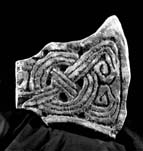Select a site alphabetically from the choices shown in the box below. Alternatively, browse sculptural examples using the Forward/Back buttons.
Chapters for this volume, along with copies of original in-text images, are available here.
Object type: Incomplete cross-arm [1]
Measurements: H. (from centre to end of arm) 19.5 cm (7.7 in); W. 21 cm (8.2 in) (across end of arm); D. 13.9 cm (5.5 in)
Stone type: As Collingham (St Oswald) 1, also surface scorched to a pink colour (7.5YR 7/4). Bedding planes seem to be sub parallel to face A. [J.S.]
Plate numbers in printed volume: Ills. 161-5
Corpus volume reference: Vol 8 p. 123-4
(There may be more views or larger images available for this item. Click on the thumbnail image to view.)
One arm of a cross-head, probably of type E10. The triple strands are quite finely cut and modelled, and the background is dressed flat.
A (broad): Triple strands emerge from the centre to cross as they lace through a triple-stranded loose ring. The outer strands join along the line of the edge moulding at the end of the arm, the two inner strands terminate in inward-facing curls. A battered flat moulding survives around most of the original edges of the piece.
B (narrow): Roughly dressed
C (broad): A triple-strap interlace extends from either side of the (missing) centre, terminating in a Stafford Knot (simple pattern E) at the end of the arm. A fragment of roll moulding survives on one curved edge.
D (narrow): Broken away and recut
E and F: Plain
This is one of a group of heads, with a limited local distribution, which displays right-angled crossing interlace of a type with links to the Isle of Man (see Aberford 3, Kirkby Wharfe 1 and 3, and Saxton 1 (Ills. 11, 432, 440 and 688); see also discussion in Chap. V, p. 49). However, as suggested in the discussion of Aberford 3, a version of the right-angled crossing is already found on face C of the cross-head Ilkley 8 (Ill. 373), and the case for similar influence is strengthened here at a site at which there is conscious indebtedness to other prestigious Anglian monuments. This suggestion is strengthened as the geology appears to show that Collingham 3 and 5 could be parts of the same cross. The triple-strand, loose ring and space-filling curls are all undoubtedly Anglo-Scandinavian features, however.



